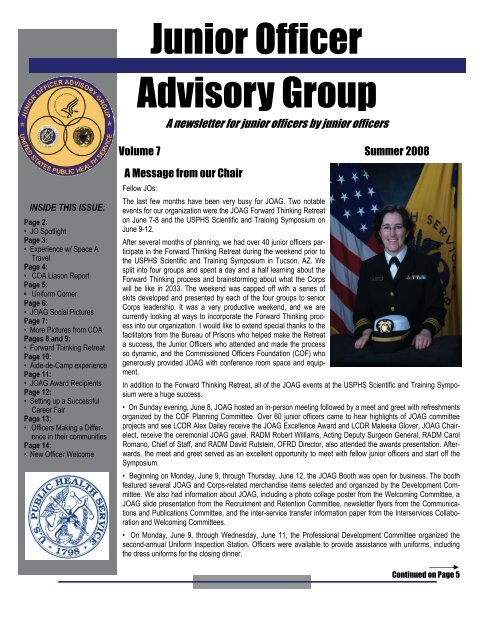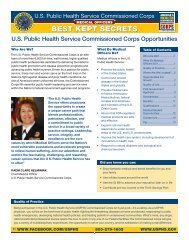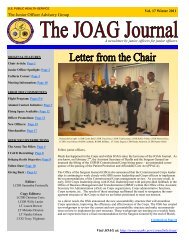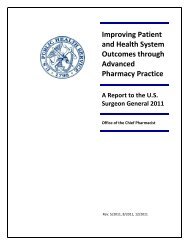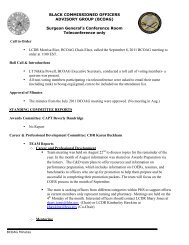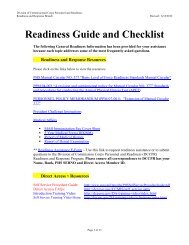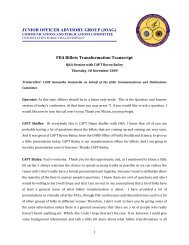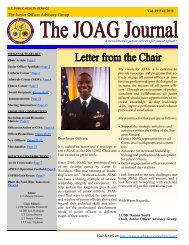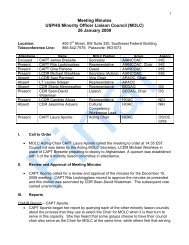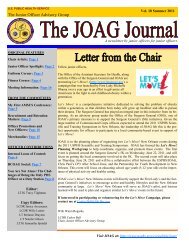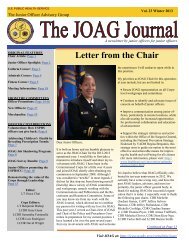Vol 7. Summer - U.S. Public Health Service Commissioned Corps
Vol 7. Summer - U.S. Public Health Service Commissioned Corps
Vol 7. Summer - U.S. Public Health Service Commissioned Corps
Create successful ePaper yourself
Turn your PDF publications into a flip-book with our unique Google optimized e-Paper software.
Junior Officer Advisory GroupA newsletter for junior officers by junior officers <strong>Vol</strong>ume 7<strong>Summer</strong> 2008INSIDE THIS ISSUE:Page 2:• JO SpotlightPage 3:• Experience w/ Space ATravelPage 4:• COA Liason ReportPage 5:• Uniform CornerPage 6:• JOAG Social PicturesPage 7:• More Pictures from COAPages 8 and 9:• Forward Thinking RetreatPage 10:• Aide-de-Camp experiencePage 11:• JOAG Award RecipientsPage 12:• Setting up a SuccessfulCareer FairPage 13:• Officers Making a Differencein their communitiesPage 14:• New Officer WelcomeA Message from our ChairFellow JOs:The last few months have been very busy for JOAG. Two notableevents for our organization were the JOAG Forward Thinking Retreaton June 7-8 and the USPHS Scientific and Training Symposium onJune 9-12.After several months of planning, we had over 40 junior officers participatein the Forward Thinking Retreat during the weekend prior tothe USPHS Scientific and Training Symposium in Tucson, AZ. Wesplit into four groups and spent a day and a half learning about theForward Thinking process and brainstorming about what the <strong>Corps</strong>will be like in 2033. The weekend was capped off with a series ofskits developed and presented by each of the four groups to senior<strong>Corps</strong> leadership. It was a very productive weekend, and we arecurrently looking at ways to incorporate the Forward Thinking processinto our organization. I would like to extend special thanks to thefacilitators from the Bureau of Prisons who helped make the Retreata success, the Junior Officers who attended and made the processso dynamic, and the <strong>Commissioned</strong> Officers Foundation (COF) whogenerously provided JOAG with conference room space and equipment.In addition to the Forward Thinking Retreat, all of the JOAG events at the USPHS Scientific and Training Symposiumwere a huge success.• On Sunday evening, June 8, JOAG hosted an in-person meeting followed by a meet and greet with refreshmentsorganized by the COF Planning Committee. Over 60 junior officers came to hear highlights of JOAG committeeprojects and see LCDR Alex Dailey receive the JOAG Excellence Award and LCDR Maleeka Glover, JOAG Chairelect,receive the ceremonial JOAG gavel. RADM Robert Williams, Acting Deputy Surgeon General, RADM CarolRomano, Chief of Staff, and RADM David Rutstein, OFRD Director, also attended the awards presentation. Afterwards,the meet and greet served as an excellent opportunity to meet with fellow junior officers and start off theSymposium.• Beginning on Monday, June 9, through Thursday, June 12, the JOAG Booth was open for business. The boothfeatured several JOAG and <strong>Corps</strong>-related merchandise items selected and organized by the Development Committee.We also had information about JOAG, including a photo collage poster from the Welcoming Committee, aJOAG slide presentation from the Recruitment and Retention Committee, newsletter flyers from the Communicationsand <strong>Public</strong>ations Committee, and the inter-service transfer information paper from the Interservices Collaborationand Welcoming Committees.• On Monday, June 9, through Wednesday, June 11, the Professional Development Committee organized thesecond-annual Uniform Inspection Station. Officers were available to provide assistance with uniforms, includingthe dress uniforms for the closing dinner.Continued on Page 5
JOAG NewsletterJunior Officer SpotlightOfficer: LT Nicole VeselyCategory: PharmacistPage 2Education: Pharm.D.The University of Pittsburgh School of Pharmacy, 2007Hometown: Pittsburgh, PAAgency: Food and Drug AdministrationCurrent Assignment and Duties:I am currently stationed with the Food and Drug Administration (FDA),Advisors and Consultants Staff. I serve as the Designated Federal Officialfor the Oncologic Drugs Advisory Committee and the Arthritis AdvisoryCommittee. In this role, I plan advisory committee meetings whichallow the FDA to gather opinions and recommendations from outsideexperts. I also maintain committee records and assure that the committeesoperate within the appropriate legal framework.Previous Assignment(s): I served as a JRCOSTEP for a few months during the summer before my last year of pharmacyschool. As a JRCOSTEP, I was commissioned as an Ensign and stationed with the Food and Drug Administration in Rockville,M.D. I served in the Division of Drug Information where I answered questions from consumers, industry, healthcareprofessionals and others regarding such topics as: MedWatch, recent FDA announcements, and pill identification. Thisassignment allowed me to gain an understanding of the work that is done at the FDA, and the role that pharmacists can playin this agency.How did you find out about the PHS?I learned of the PHS while in my second year of pharmacy school during a career fair held at my school. The PHS officerwho attended the event provided a great description of the USPHS and the opportunities that were available to me as a studentas well as a pharmacist.What was the most challenging part of applying for the PHS?I think the most difficult part was completing the medical forms. I would suggest going to a Military Entrance ProcessingStation to complete the medical forms as civilian physicians may not be aware of the exact way the forms are to be completed.Also, be sure to make copies of everything that is submitted.What are your goals with the PHS?I hope to take my experiences in my current position and as an officer to promote public health and the PHS. I also plan topursue a Masters in <strong>Public</strong> <strong>Health</strong>. I look forward to my future career with the PHS.What is your most memorable PHS experience so far?I enjoyed attending the BOTC class where I met other PHS officers and learned about their experiences in the PHS.What advice would you give to prospective PHS applicants (or other Jr. Officers)?Although the application process may seem tedious, once you are appointed as an officer in the PHS, you will realize that itwas all worth it and that you are now part of something larger. I have found the sense of camaraderie within the PHS to bevery high and have never come in contact with an officer who is not willing to help another officer or applicant. Although timeconsuming, complete the application process and you will find yourself belonging to a group of committed officers, includingmyself, willing to help you during your transition into the PHS. Email: nicole.vesely@fda.hhs.gov
JOAG NewsletterPage 3Have you tried Space A travel yet?Contributed by LT Robert C. Horsch, on behalf of the JOAG Professional Development CommitteeAre you afraid Space A Travel may be too complicated? Thisis how my wife and I felt when we started talking about ourtrip to Spain in September. We traveled with our two children,which can make even the simplest vacations difficult.Our first Space A experience was memorable and challenging,but it was also incredible, and not just because of thebeauty of Spain.My wife and I started planning our trip to Spain in Decemberof 2006. We went through the same routine as previoustrips: when to travel, how long we should stay, what we wantto see while we are there. This was not our first trip to Spain;we try to visit a new area each trip. We are fortunate to havefamily in Spain, which helps to dramatically lower the cost.But, this year the low air fare never materialized. In March, Imentioned that we could always try Space A military flights.At first, I completed the research mostly on a whim waiting forthe commercial fares to drop. When they didn’t, and thelooming expense of four seats really started factoring into thevacation budget, I dove into the research full force.While many sites on the benefit exist, there are two websitesthat have compiled all of the information you need in preparingfor a trip using Space A. Some sites and resources requirepayment, but I do not believe they are necessary. Thefirst site I found was Dirk Pepperd’s Space A MessageBoard. It truly is a message board where individuals posttheir experiences as the primary content. Most importantlythe site has a link to another critical information web page,John D’s Space A FAQ. These two pages go perfectly togetherwhich is why they frequently mention each other intheir internal links.Traveling Space A was unlike any vacation we had previouslytaken. The necessary first step was for me to sign upusing the link on Dirk’s page “Space A signup” at 12:01 A.M.on my first day of leave. You can sign up by faxing oremailing specific terminals, but the link I used made it muchsimpler. (Remember, only retirees can sign up using thesixty day time limit, and active duty personnel cannot sign upuntil their first day of leave.) I entered the information requestedand received the confirmation email back from Dirk’spage. (Note: If you choose ALL as a destination you will beavailable for all flights leaving from your chosen military baseor airport.) You need to keep this email with you along withyour Military IDs and your leave slip. You can always usethis as proof for your signup date which determines yournumber in line. Next, we identified a potential flight usingDirk’s time schedule section of the webpage. We arrived atDover AFB for our flight’s “Roll Call” only to find it delayed fortwelve hours. This was not a big deal except for the fact thatthe time changed from 2 A.M. to 2 P.M. the next day. Ichecked in with the attendant at 1 P.M. and was given mytravel slip detailing my category (active duty is category III), mynumber in line (Julian date format based upon when yourleave started), number of passengers, and estimate of weightsfor each passenger, after which the waiting starts. While youwait, you can check the monitors to see if any informationabout your flight is available.The most important item on the monitor is the number of seatsavailable. Our flight listed only ten seats. “Show time” startedfifteen minutes late and the waiting area was pretty full sincenot many flights had gone to Spain recently. Fortunately (forus not them), most of the people waiting were category VI(retirees) which allowed all of the active duty personnel onleave to make the flight plus one lucky retiree couple. This iswhere the camaraderie starts. Up until this point it is tense inthe room as people wait to see if they made the flight, but oncepeople know everyone starts talking. It is amazing howfriendly people are when traveling Space A. We had peopleoffer to carry everything for us, including our kids!Less than two hours later an announcement called for allmanifested passengers to make their way to the departuregate. We boarded a bus and were soon climbing multiple setsof stairs inside the football field that is a C-5. Wow! Returningfrom Spain to Dover was a similar experience except thatflights were canceled for four days. This is why it is importantto call the terminal directly. We arrived again for the first flightand ended up staying in Rota for four extra days when wecould have been visiting new places. We learned for the nexttime.All in all it was an amazing experience. I was amazed at hownice and helpful everyone was within the process. The staffdid not always give the answer I hoped for, but they went outof their way to assist. The best part was that for the price offour plane tickets we were able to pay for our entire trip. I amnot ready to jump onto a Space A flight again soon, but we willdefinitely do it again in a few years, when the kids are a bitolder.Editors Note: More information on Space A travel can befound in the Winter 2007 JOAG newsletter.
JOAG NewsletterCOA – Your AssociationContributed by LCDR Jonathan RashI have been privileged this year to serve as the JOAG liaison to the <strong>Commissioned</strong>Officer’s Association (COA) Board of Directors. Working with COA has been aneye-opening experience. From the first meeting I attended back in August in Washington,D.C., I knew I was getting a rare opportunity – to learn about many of thelarger forces shaping the <strong>Corps</strong> and how WE can help to steer those forces to thebenefit of the <strong>Corps</strong>.Let me reiterate that last point – each one of us can indeed shape the future of the<strong>Corps</strong>. Take a minute and let that sink in, because I think too many of us take it asgospel that there are major external forces steering the <strong>Corps</strong>, and there’s nothingwe can do about it. The former may be true, but the latter most certainly is not.We all have opportunities to shape the <strong>Corps</strong>. We participate in JOAG knowing thatsenior leadership within the <strong>Corps</strong> has increasingly solicited and incorporated juniorofficer input in shaping the <strong>Corps</strong> policies and activities. This is great – I couldn’t bemore proud of what JOAG has accomplished. But there are limits on what we inJOAG or our senior leadership can accomplish from within. This is where COAcomes in.COA’s mission is to advocate for the <strong>Commissioned</strong> <strong>Corps</strong> and its officers. TheAssociation employs two lobbyists – Executive Director Jerry Farrell and GovernmentRelations Director Judith Rensberger. Their access to members of Congressand officials within the White House Administration is sometimes limited, primarilybecause COA is a small organization with small membership, struggling to have itsvoice heard over those of other much larger and more powerful organizations. COAhas always maintained a non-partisan approach to its advocacy.Realizing that COA cannot maximize its effectiveness by lobbying alone, it hasformed partnerships with other organizations. Partnering with such organizationsas the American <strong>Public</strong> <strong>Health</strong> Association, the Military Coalition, and the Trust forAmerica’s <strong>Health</strong> has allowed COA to amplify its voice on critical issues to the <strong>Commissioned</strong><strong>Corps</strong>. Indeed, without such partnerships, many COA victories over thelast 10 years would not have been possible.It is not possible to go over every initiative or accomplishment COA has been involvedin over the last year. To learn more about COA, its initiatives, its accomplishments,and its other programs, visit the website at www.coausphs.org. Thewebsite also includes instructions on how to become a member, how to join thelistserv, and other things you should know.As I previously mentioned, there are many ways you can help shape the future ofthe <strong>Corps</strong>, and COA provides many of these opportunities. See the sidebar (right)for a list of things I’d recommend for any junior officer who wants to get more involvedin shaping the <strong>Corps</strong>. I will be completing my term as JOAG liaison to COAat the end of September, but I have just been elected as a Field Representative onthe COA Board of Directors, and started my three year term in that capacity on July1 st . You are all welcome to contact me any time with questions or issues you’d likeme to bring before the Board.I would like to urge each of you to see the <strong>Corps</strong> and its future not in terms of hugeexternal forces beyond our control, but in terms of major challenges that we collectivelycan face and overcome. Working both within the <strong>Corps</strong> in organizations likeJOAG and outside the <strong>Corps</strong> through the <strong>Commissioned</strong> Officers Association, YOUcan help shape the <strong>Corps</strong> this country needs.Get involved!Page 41. If you aren’t a member of COA, youshould join. About 75% of all active dutyofficers are members. Membership duessupply a majority of the funding the Associationreceives each year.2. Join the COA listserv so you can stayinformed of what COA is doing.3. Become involved with your local COAbranch.4. Make donations to COA or to its sisterorganization, the <strong>Commissioned</strong> OfficersFoundation (COF).5. Write your elected representatives. As aU.S. citizen, you have the right to petitionyour own elected representatives about issuespertaining to the USPHS <strong>Commissioned</strong><strong>Corps</strong>. Be careful to write such correspondenceon your own time, using your ownstationary, word processor, etc. and not thegovernment’s. You may identify yourself asa <strong>Commissioned</strong> <strong>Corps</strong> officer, but may notmake it appear that you are writing in yourofficial government capacity representing theposition of your Operating Division, Agency,or the <strong>Commissioned</strong> <strong>Corps</strong> itself.6. Don’t be afraid to write the COA ExecutiveDirector Jerry Farrell directly. He is alwaysopen to input from <strong>Corps</strong> officers.<strong>7.</strong> Get to know the COA Board of Directors.The Board of Directors consists of representativesfrom each category, as well as fourfield representatives, three retired officers,and one inactive reserve officer. MOLC andJOAG also have ex-officio liaisons to theBoard of Directors. Establish a relationshipwith one or more Directors or liaisons. Theymay be able to direct you to opportunities tovolunteer to help COA at the national level.You may even want to consider nominatingyourself to be a member of the Board of Directors.
JOAG NewsletterPage 5A Message from our Chair (continued from Front Page)• On Wednesday, June 11, I had the honor of presenting the Junior Officer of the Year Award to LT Kim Kwang, and the ViceAdmiral Richard H. Carmona Inspiration Award to CAPT (ret.) Eugene Migliaccio during the Symposium Awards Luncheon.• On the evening of Wednesday, June 11, JOAG hosted its annual Social at El Minuto Café. Over 70 junior AND senior officersattended. We were pleasantly surprised to have several of our senior leaders in attendence.On behalf of JOAG, I would like to thank all of the officers who volunteered their time to make these events such a success. Inaddition, I would like to thank all of the JOAG committees that participated in coordinating, staffing, and providing information,including the Awards, COF Planning, Communications and <strong>Public</strong>ations, Development, Interservices Collaboration, ProfessionalDevelopment, Recruitment and Retention, and Welcoming Committees. And finally, a special thanks to all of the juniorofficers who volunteered to assist COF as moderators and registration booth attendants during the Symposium.On a personal note, attending the Symposium is always a highlight of the year for me, and this year was no exception. I especiallyenjoyed this year because I had the opportunity to meet so many officers that I had previously only communicated with bye-mail or phone. In addition, the Symposium has something that other professional conferences do not have--esprit de corps.<strong>Commissioned</strong> <strong>Corps</strong> officers are truly a unique and dedicated bunch, and we all share many of the same experiences. Forexample, we all face similar challenges and rewards in balancing our jobs, our <strong>Commissioned</strong> <strong>Corps</strong> responsibilities, and ourfamilies. Also, we all share the same mission: to protect, promote, and advance the health and safety of the Nation. It was hardnot to be overwhelmed by this solidarity and camaraderie when looking at a sea of uniforms at every turn. I am already lookingforward to next year’s Symposium in Atlanta, GA, and I hope to see many of you there!All my best,LCDR Aimee TreffilettiUniform Corner: Placement of the Garrison Cover Under the Belt
JOAG NewsletterPage 6JOAG Social held at USPHS Scientific & Training SymposiumContributed by LCDR Sonny SainiOver 70 PHS officers attended the JOAG Social on June 11, 2008 at ElMinuto Café in Tucson, AZ. Officers were able to relax and mingle with oneanother during the social. The evening was highlighted by a visit from theActing Surgeon General RADM Steven K. Galson (pictured bottom, right).RADM Galson spoke to the junior officers about their experiences duringthe USPHS Scientific and Training Symposium. Several other Flag Officerswere in attendance and helped make the event a memorable one for theJunior Officers.
JOAG NewsletterPage 712Reconnecting and getting to knowfellow officers while preparing for the eventsTaking in the sites around Tuscon, AZ4 3Meeting the Acting Surgeon GeneralCompleting New Year’sResolutions, like running in theSurgeon General’s 5K Run/Walk5Pictured: 1-left to right back row - LT Ed Zechmann, LCDR SonnySaini, LCDR Scott Colburn, LT Dan Brum; front row - CDR EliseYoung, CDR Goy Yee Lum, LCDR Jialynn Wang. 2- LDCR DustinRider, LT Christine West, LTJG Stacey McBryde, and LCDR AnneRogers (Nurse Category Day planners for the 2008 COF conference)3-LT Jennifer Bebo (Aide de Camp for 5K Run) for RADM Galson 4LT Jessica Schwarz, JOAG Secretary 5-IHS Officers from Navajo/Oklahoma areasHanging out with co-workers andfriends
JOAG Newsletter Page 8Thinking About the Future: Recap of the JOAG Forward Thinking RetreatContributed by LCDR Amy ConstantineOn June 7 – 8, 2008 over 40 USPHS juniorofficers gathered in attendance for the JOAGForward Thinking Retreat at the 2008USPHS Scientific and Training Symposiumheld at the Tucson Convention Center MohaveRoom in Tucson, Arizona. Scott Murchie,Chief of Staffing and Recruitment,<strong>Health</strong> <strong>Service</strong>s Division, BOP introducedhimself and led the introductions that beganaround the room with each officer announcingboth their name and agency.A Forward Thinking Review Team had earlierbeen established in spring 2004 to overseethe process of guiding the Bureau of Prisons(BOP) Agency toward its “best case” future,offering ongoing training to Bureau staff onForward Thinking processes, providing information,researching trends, and supplying aForward Thinking element in all new BOPefforts. This review team provided the modelfor the Forward Thinking concepts presentedto the PHS Junior officers. RADM NewtonKendig, Medical Director, BOP had longbeen a driving and very supportive force ofForward Thinking and was also in attendanceat this JOAG retreat.Facilitators were present at the retreat toassist and guide the junior officers. Thefacilitators included: Scott Murchie, JulieWands (Deputy Assistant Director for <strong>Health</strong><strong>Service</strong>s Division, BOP), CAPT Chris Bina,CAPT Nick Makrides, LCDR AngelaMtungwa, and LCDR Hollie Cook.Why were a roomful of Junior PHS officersassembled? The central point of the retreatwas to teach junior officers to develop ForwardThinking skills and use them for theenrichment and future direction of the <strong>Public</strong><strong>Health</strong> <strong>Service</strong>. The purpose of the retreatwas to see if the use of the Forward Thinkingprocess would be a valuable tool for futureuse in the PHS. The idea would be to developthoughts and track trends to enable the<strong>Public</strong> <strong>Health</strong> <strong>Service</strong> to become a successfuland impacting uniformed service.(Below) Officers acting out their skit asprior Surgeon GeneralsJunior PHS officers were asked “What will theworld look like in the next 25 years?” and thenproceeded to incorporate the seven steps of theForward Thinking Process.Step 1 of the Forward Thinking Process involvedbrainstorming ideas in six different categories:Social (S), Technological (T), Economic(E), Environmental (E), Political (P), and Ethics(E) = STEEP + E. After everyone introducedthemselves within their new group, they alsoindividually contributed a trend that would beseen in “2033,” respective to the assigned category.Further brainstorming ensued.Step 2 involved List and Cluster Trends. Officerswere asked to identify similarities in the biglist they created and then combine and clusterthe ideas most like each other’s. Trend statementswere then created for the clusteredideas. The direction of the trend was established,whether decreasing or increasing. Thegoal was to end up with 20 – 25 trend statements/cluster.Step 3 involved Issue Impact analysis. A gridto be placed on the floor and made from maskingtape was made in the shape of a cross. Onindex cards, “High Impact” was written andplaced at the top, “Low Impact” at the bottom,“Very Unlikely” to the right, and “Highly Likely”to the left. The 20 – 25 trend statements/cluster(Above) Officers contributed ideas duringthe STEEP+E processidentified in step 2 were written on separateindex cards. The cards were placed one ata time onto the center of the grid and thevoting process began, whereby each personcould vote on a trend care only once.Each person could move the trend card sixinches right or left on the grid.Step 4 referred to reviewing results andpreparing a presentation. Officers had toobserve which trends ended up in the topleft quadrant (highly likely and high impact)and then prepare a five to ten minute presentationbased on the top trends exhibited.Step 5 focused on the Wildcard Exercise.In groups of two, wildcards were brainstormedfor five minutes. A member of thegroup was chosen to later share the wildcards.Step 6 showcased the creation of scenariosdepicting how the future might unfold. Oneof the top trends was chosen to begin. Adiscussion followed to determine how thistrend would be represented in the scenarioand whether it would be: expected/best/worst case, or wildcard.This process was then repeated for theother top trend areas. The last step featuredthe preparation of scenario presenta-Continued on next page
My experience as an Aide-de-camp at COA 2008Contributed by LTJG David SchwabThe #1 rule of being an Aide-de-Camp…..”Don’t lose your Principal”.When I responded to LTJG Jeffrey Strich’s email asking for volunteers to serveas Aide-de-Camp at this year’s COA Conference, I really had no idea what toexpect. I knew that it would be an excellent opportunity for a junior officer tomeet the current leadership of the <strong>Commissioned</strong> <strong>Corps</strong>. For those officersthinking about going to the next COA and think you would like to be an Aide-de-Camp, I offer the following story about my experience.Since this was going to be my first COA Conference since joining the <strong>Public</strong><strong>Health</strong> <strong>Service</strong> in December 2007, I initially felt a little overwhelmed. I thoughtthat maybe I would accidentally do something stupid and be relieved of duties orworse. As things turned out, this was not the case. Each volunteer was sent adetailed PowerPoint presentation with instructions on how to be an Aide. Therewere many protocols covered that would come into play once you are assignedto an Admiral. I received an email the week before the conference that I wasassigned to Admiral James Galloway. I was instructed to contact him to makescheduling arrangements for the trip. I was a little intimidated at first since I didnot know him, so I did a trusty Google search to get as much information abouthim as possible. I was very impressed with what I saw. Admiral Galloway wasselected as the USPHS ClinicalPhysician of the Year in 2005 andwas recently promoted to RearAdmiral Assistant General! I alsonoticed that he went to the MedicalCollege of Virginia, which isn’t toofar from where I live in the DC area.I sent him an email letting him knowthat I had been assigned as hisAide-de-Camp for the upcomingconference. I attached a copy of myCV so he would know a little bitabout me. I received his responseto my initial email within the hour inwhich he extended his thanks to meand advised me that he lookedforward to meeting me.Upon arriving in Tucson, I remainedin contact with Admiral Galloway byemail. He had informed me that hewas staying with family in the areaand would be renting a vehicle. Wehad decided beforehand that wewould meet on Sunday afternoon. Since I got in on Saturday, I had time to prepare.The first thing I did was get the weekly schedule of events happening atthe conference. I had already let him know what events I had planned on attendingand he encouraged me to attend them. As I looked through the scheduleof events, I noticed that he was scheduled to do a presentation on CategoryDay and made note of the time and location. I was staying at the Hotel Arizona,only a short walk to the Tucson Convention Center where most of the activitieswere being held during the week.Admiral Galloway informed me via email on Sunday that his flight got delayedand that he wasn’t going to get in until later, so we adjusted our plans to meetMonday morning in the lobby at the Hotel Arizona. As a courtesy, I called himJOAG Newsletter Page 10LTJG Schwab (2nd row, far right) and the rest of the Aides pose for agroup picture with RADMs Romano, Galson, and Williams.early Sunday evening to make sure that he had arrived safely, which hemost definitely appreciated. Admiral Galloway called me when he arrived atthe Hotel Arizona Monday morning and I headed to the lobby to meet him forthe first time. I recognized him instantly from the pictures I had seen duringmy Google search. I waited as he exchanged greetings with other officers,some of them Admirals, and then introduced myself. As we made our wayover to the Tucson Convention Center, I started to recount the protocols ofbeing an Aide-de-Camp. I remembered what they told us the day before inour Aide-de-Camp meeting and what was taught in the Officer Basic Course.As we made our way to the Convention Center, I maintained my position tohis left and slightly behind him and made sure to open the door for him aswe entered the building. Admiral Galloway couldn’t have been any friendlieras we proceeded to the registration desk and he was greeted by other officers.He even made a point to introduce me to the other Admirals present.The week really flew by very quickly as I got off to an early start each morningto meet Admiral Galloway either in the lobby or at the convention center.My main objective was to make sure that he knew where he was supposedto be and that he got there on time. As I would soon discover, things have away of getting out of whack and don’t always work out as planned. This wasthe case during the awards luncheon when Admiral Galloway had to tend toimportant matters on a conference call and arrived a little late to the awardsluncheon. Of course I knew this since I had seen him on the phone and hesignaled to me to go ahead, and hewould come in after he finished upwith his call. In fact, he was sosmooth entering the ballroom that Ihad to be tapped on my shoulder bya fellow Aide-de-Camp to advise methat he was there! I joined him athis table and we watched the remainderof the award presentations.Throughout my experience as anAide-de-Camp, I was fortunate tointeract with many other <strong>Commissioned</strong>Officers. One of the highlightsof my Aide-de-Camp experiencewas being able to sit in on theSurgeon General’s meeting onWednesday afternoon, which wasattended by all of the Admirals.Following this meeting, we wereinvited to the VIP dinner receptionbeing held at the Hotel Arizona. Weended the reception with a groupphoto which included all of theAides. Since I was leaving the next morning, I knew that my time as AdmiralGalloway’s Aide-de-Camp was coming to a close. Soon after our groupphoto, Admiral Galloway began preparing to call it a day. He offered me asincere thank you and has since emailed me to offer praise in my duties ashis Aide-de-Camp.I would like to thank Admiral Galloway for making my first COA/COF Symposiuma memorable one. Looking back, I know that the Aide-de-Camp experienceis something that is going to benefit me for years to come. I hopethat my story has provided some guidance and motivation for future Aide-de-Camp tours.
JOAG Newsletter Page 112008 JOAG Award Recipients JUNIOR OFFICER OF THE YEARLT Kwang Kim Dietician IHS Kayenta, AZ JOAG EXCELLENCE AWARDLCDR Alex Daily Engineer IHS Spokane, WA VADM CARMONA INSPIRATION AWARDDr. Eugene Migliaccio CAPT (Ret) <strong>Health</strong> <strong>Service</strong> Bethesda, MD
JOAG NewsletterSetting up a Successful Career FairContributed by LT Chris Fletcher & LCDR Alex Dailey, on behalf of the JOAG Recruitment and Retention CommitteePlanningWhen planning to attend a career fair it isimportant to remember “the 5 Ps”, ProperPlanning Prevents Poor Performance. Planningwill help you avoid late arrivals, ensuresharp displays, and help demonstrate to curiousstudents that the USPHS is the world’spremier public health service. It is important,more so now than ever, to plan ahead to securefunding for career fairs as it can now takeup to 90 days to be approved through OCCO/DCCR.To find an upcoming career fair event, checkthe JOAG website for career fair listings underthe “Career Fair Info” button. Also, check withyour Associate Recruit Lead (ARL) for careerfairs that might not have made it to JOAG’slist. It is a good idea to become familiar withthe colleges and universities in your area andthe programs they offer. Check their websitesfor career fairs and a calendar of events.When inquiring about a career fair, check toensure that no one else from the PHS hasalready registered for a booth. This will avoidduplicating efforts and registration fees.Once you find an event to attend, you mayneed to find a funding source to pay for yourregistration fees. Most career fairs charge aregistration fee. First, ask the career fair organizerif fees are waived for the federal government.In most cases, funding can be securedthrough either your ARL or through youragency. On occasion, funding is availablethrough your Professional Advisory Committee(PAC).After you obtain approval and funding to attenda career fair, contact your ARL 30 days inadvance to obtain promotional materials. Determinewhether you will target a particularaudience or promote the PHS in general. Recruitingmaterials are available for generalPHS and category-specific events. Potentialrecruits will not be impressed if they walkaway empty-handed. Also, consider locating aPHS flag, table skirt or table display from yourlocal COA chapter. You want your display tostand out!Familiarize yourself with categories other thanyour own. Be prepared to answer basic questionsabout opportunities in other categoriesand have a fact sheet available for each categorywith contact info and the category PACweb address.Advertise your visit if possible. On the JOAGwebsite, Career Fair Information Page, findthe Recruiter Information and Resourcesdocument, there is an embedded documentMission of the <strong>Corps</strong> that can be sent ahead topost at the school in the buildings that yourtarget audience uses. If you are familiar withthe faculty of the programs from which yourecruit, ask for their help in posting a few fliersin the class rooms prior to the career fair. If theschool is nearby, don’t be hesitant to visit theschool and post them yourself (check with theschool regarding posting procedures first).PreparationEarly is on time, and on time is late. You wantto arrive in time to find parking, orient yourself,and set up the table display. Be prepared! Weare a uniformed service and we should carryourselves as such. The public expects preparednessand precision. If we are competingwith the Armed forces for recruits, we need todo more than just wear our uniform and smile,we must act the part. Be sure to carry a fewbasic office supplies with you such as a stapler,paper clips, binder clips, tape, and don’tforget business cards. A laptop is helpful forPowerPoint displays and to access the CareerFair Resource document. Don’t forget extracash for lunch! Standing on a gym floor all dayis no fun on an empty stomach.ImplementationMake sure your display stands out. Practiceassembling the display at home to avoid confusionon the day of the event. This will giveyou plenty of time to make sure you have theparts and pieces and to clean as well as inspectthe display for damage.Once your display table is set-up, stand infront of the table (not beside and certainly notbehind) ready to greet those who walk buy.Don’t wait for the career fair attendees toPage 12speak to you, go and get them; some studentsmight be shy or hesitant to approachyou because of your uniform (fresh from thecleaners with all devices in the correct location,straight and level; shoes polished to ahigh shine or cheater shoes if you don’t polish).Be prepared to explain the pay scale andbenefits, especially for the categories thathave bonuses. Remember to smile andspeak kindly to everyone.Have a sign-in sheet on hand with largespaces for interested persons to give youtheir information. You should collect the student’sname, cell/home phone number, emailaddress, major/area of interest in the <strong>Corps</strong>,year in school, and expected graduation dateso that you can follow up after the career fair.In the near future, this information may beused to improve the effectiveness of recruitingevents.If there are two or more officers at the display,take advantage of any lulls in thecrowd. Do a little reconnaissance, walkaround the career fair looking at what otherrecruiters are doing to attract students attentionwhether it is a new give-a-way gimmickor an interesting display.Follow-upIt is extremely important that you follow upwith the potential applicants from whom youhave collected information. If any had questionsthat you couldn’t answer on the spot,call the number they gave with your answersor forward their inquiries to someone whocan help. You should compile the contactinformation from your sign-up sheet and forwardit to the appropriate ARL or Categoryrepresentative.Once you get back, don’t forget to fill out theActivity Reportt. Email the completed reportto your ARL and the Associate RecruiterProgram. Make sure you return borroweddisplay boards and other materials. Storesurplus promotional materials and startsearching for the next event.
JOAG NewsletterPage 13Officers on Ice: Helping kids with disabilities play hockeyContributed by LTJG David SchwabCompetitive sports have always been a big part of my life growing up. At this point in my life, I am still an active participant in avariety of sports such as golf, tennis, and basketball, but the sport that I have come to grow the most passionate about is icehockey. I got involved in coaching youth ice hockey three seasons ago with the Montgomery Youth Hockey Association inRockville, MD. I didn’t start playing hockey until I was in high school and therefore never had the youth hockey experience.When the opportunity came about to get involved with a new Special Hockey team forming in Rockville, I immediately becameinterested.Special Hockey is a programthat was created for the enrichmentof the athlete with adevelopmental disability.Although many are athleteswith autism, there are athleteswith other types ofmental and physical disabilities.In addition to physicalhockey skills, the programemphasizes the developmentof desirable individual characteristicssuch as dependability,self-reliance, concentration,willingness to shareand personal accountability.I’ve found that many of theseattributes are also importantto exhibit as a <strong>Commissioned</strong>Officer in the <strong>Public</strong><strong>Health</strong> <strong>Service</strong>.Montgomery Cheetahs pose for team picture in between games with Coaches David Lucia (back left) and LTJG DavidSchwab (back right).A good friend of mine andfellow PHS Officer has a sonwith autism so I thought itwould be a great idea toinvite him to participate. Thiswould be the first officialpractice in what would becomethe Montgomery Cheetah’s hockey program. We showed up and we were joined by Bob Banach, one of the coachesfrom the Northern Virginia Special Hockey team and Mike Hickey, who is the President of the American Special Hockey Association.This was back in October of 2006. In a year and a half, our team has grown immensely. We have almost 30 athletes,ranging in age from 6 to 17 years old. The team has participated in 2 tournaments, last year close to home in Arlington, Virginia,and this past April in the United States Disabled Festival.As we look to start our third season of Cheetah’s hockey, the program continues to grow. The athletes continue to improve inways that their parents probably never imagined. It is my experience that the very core values expected of a <strong>Commissioned</strong><strong>Corps</strong> officer are strongly linked to the success of this hockey program. In 2007, the program received the Michael H. TaffAward which is given to a business, non-profit employer or individual whose contributions have improved the lives of peoplewith disabilities. This past April, the Cheetahs received the Governor’s <strong>Vol</strong>unteer <strong>Service</strong> Award. Through the leadership andservice provided by the coaches, parents and mentors, the athletes have been able to learn many new skills that they otherwisemay never have tried.It is with integrity and excellence that everyone involved in the program has come together to form a hockey family. I am proudto be part of that family.
JOAG NewsletterPage 14ATSDR:LTJG Dawn M. ArlottaBOP:LCDR Mark J. MacyszynLCDR Leonard C. MurdockLT Julia D. BurchfieldLT Troy A. LitsinbergerLT Janessa B. MeltonLT Kellie W. ObriantLTJG Nikki L. CanadaLTJG Thomas R. LilesLTJG Theresa A. McKinneyLTJG Regina Y. PetersonLTJG Westbrook E. WalshLT David J. SchatzLT Penny M. StrotherLTJG Nakisha L. StricklandLT Stanley W. BennettLTJG Darren W. HearnLT Steven C. SpenceLTJG Marie-Elena C. PuleoLT Angela F. HutsonLCDR Patricia D. CorbinLT Zerita BomaniLT Mark L. KimmerlingLTJG Cynthia F. WilliamsLCDR Trena A. GoodwinLT Brian J. EddyLT Scott N. LabrecqueLT Sekhar G. IyerLTJG Vanessa D. PattersonJOAG Welcomes 119 Newly <strong>Commissioned</strong> Officers! CDC:LT Harlem J. GunnessLT Heidi L. Hudson LT Robert S. Swain LT Denise M. Gaughan LT Alpa Patel-Larson LT Shannon M. Lee CMS:LT Anitra CustalowLT Shary M. JonesDHS:LT Jesse M. LarsonLT Tania D. ThorneLTJG Chandra N. EmanuelLT Janis M. McCarrollLT Nicola J. PerryLTJG James M. SpeckhartLCDR Martin Ruiz-BeltranLT Melinda D. WelkaLCDR Teresa BaptisteLT Junio R. ColobongLCDR Diana L. LiebnerLT Humberto VillalobosLTJG Shatara J. SherwoodLCDR Martin Ruiz-BeltranLT Gerarda W. PersadDOD:LT Richard P. SchobitzThis newsletter has be provided by the JOAG Communications & <strong>Public</strong>ations Committee For information on how tocontribute to future editions, please contact LCDR Lori Hall, committee chair FDA:LT Shannon L. HillLT Hai Lien T. PhungLTJG Tonya S. JohnicanLT Kristina E. EstesLT Shannon L. HillLT Yvette W. WaplesLT Joseph D. KellyLTJG Quynhnhu T. NguyenLCDR Timothy G. JettonHRSA:LT Nahleen C. HeardIHS:LT Vera C. MosesLTJG Jonathan D. MerrellLTJG Yvette M. PaceLTJG Belinda L. RooneyLTJG Carrie L. SchulerLT Benjamin A. MarnellLTJG Aaron F. McNeillLT Lindsay D. GatrellLT Michell R. MathewsLCDR Leeann B. JohnsonLCDR Robert KeseadLT Amy D. EdenLT Alisha M. LarsonLTJG Jacqueline L. KouadioLTJG Melissa M. MartinLT Michael R. HarrisonLTJG Beth R. CloosLTJG Caleb J. MeyerLT Peter J. MitchellLTJG Megan M. ArndtLTJG Racheal M. LeeLT Maria YazzieLTJG Donald R. GrahamLT Courtney W. SikesLT Justin B. SikesLT Brian J. HamiltonLT Thomas O. MeyersLT Callandra K. MikeLT Susan WolffeLTJG Jonathan M. McBrideLTJG Michael S. StroudLT Tanya H. DavisLT Matthew P. HessLTJG Molly A. BastianLT Jack T. MohrLT Philip J. SiebigterothLTJG David A. YoungNIH:LT Jonathan D. WhiteLT Jeanne M. ChamberlainLT Jennifer C. Graf LCDR Demetrio L. Domingo LTJG Tokunbor A. LawalOS:LTJG Alexander AmankwahLT Janette E. Yu-ShearsLTJG Eric G. ShellPSC:LT Susan A. Steinman LCDR Todd E. Johnson LT Edward W. Wroblewski III SAMHSA:LT Jasmyn K. ZacheryLT Angela D. RichardsonLT Chen-Tin TsaiLTJG Jamila R. DavisLTJG Natalie K. GibsonUSDA:LT Jaspreet K. GillLT Kevin M. GreeneLT Temeri D. Wilder-KofieLCDR Mehrdad Amani, Dental Category LCDR April Kidd, Nurse Category LCDR Philantha Bowen, Nurse Category LCDR Diem-Kieu Ngo, Pharmacist Category LCDR Rhondalyn Cox, <strong>Health</strong> <strong>Service</strong>s Category LCDR Mark Osborn, Physician Category LCDR Jean Pierre DeBarros, <strong>Health</strong> <strong>Service</strong>s Category LCDR Dianne Paraoan, Nurse Category LT Blakeley Denkinger, Dietician Category LCDR Thomas Pryor, Ex-officio LCDR Jessica Feda, Therapist Category LCDR Jonathan Rash, Engineer Category LCDR Maleeka Glover, Scientist Category LCDR Michael Schmoyer, At-large member LCDR Lori Hall, Pharmacist Category CDR Erica Schwartz, Physician CategoryLCDR Rich Henry, <strong>Health</strong> <strong>Service</strong>s Category LT Jessica Schwarz, Environmental <strong>Health</strong> CategoryLCDR Kristina Joyce, Pharmacist CategoryLCDR Julie Sinclair, Veterinary CategoryLCDR Aimee Treffiletti, At-large member


